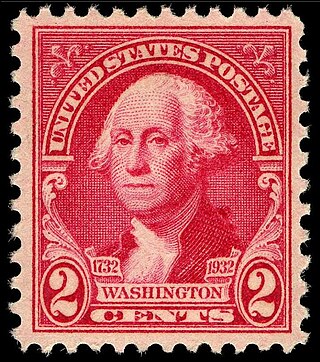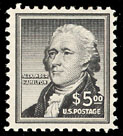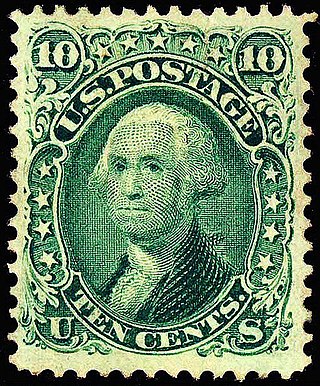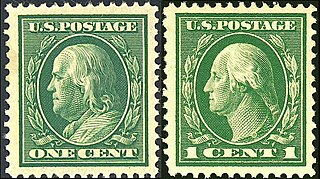
Coil waste is a type of U.S. stamp made from damaged or unusable printing stock intended for use as coil stamps and is a term applied to several stamp issues of the late 1910s and early 20s.

Coil waste is a type of U.S. stamp made from damaged or unusable printing stock intended for use as coil stamps and is a term applied to several stamp issues of the late 1910s and early 20s.
Sometimes in the printing of coils on rotary presses, several stamps from the run were deemed unusable for coil production. Instead of discarding these, the Bureau of Engraving and Printing processed them through the flat-plate perforating machine to finish them as fully perforated stamps. These finished products are known as coil waste. While seemingly identical to normal fully perforated issues (which were printed on flat plate presses), coil waste stamps are distinguishable by their size: their designs are slightly wider or longer than normal because rotary press printing slightly stretches an image.
The stamps removed from coil production in the late teens and early twenties were "discarded as unfit," according to a report from a director of the Bureau of Engraving and Printing "on account of narrow margins, too close perforations, and other reasons." [1] A notable example is a 1919 1¢ Washington stamp (Scott Catalogue #538). This, according to Max Johl, had "received the regulation one way [vertical] coil perforation while forming part of the long rolls of stamps printed on the rotary press. The coil perforating machines…fitted for perforating rolls of stamps could not be used to perforate sheets, so these [stamps] had to be perforated the other way (horizontally) on the regulation eleven gauge flat plate perforating machines." [1] The rarest coil waste issue from the Washington-Franklin series is another 1¢ Washington stamp produced in 1921 (Scott #544). Other Washington-Franklin examples include Scott #539-541.

In 1923, during the production of the U. S. Fourth Bureau definitive series, four coil waste issues were made from short ends left over after the long printed rotary rolls had been cut into proper coil lengths (such as 500 or 1000 stamps). The excess production occurred in the coil versions of the 1¢ Franklin and 2¢ Washington stamps (Scott #597 and 599). One batch of each issue had been perforated 10 vertically, and those stamps were then perforated 11 horizontally to produce Scott #578 and 579; the remaining, smaller group of short ends had not been perforated, and these were finished with gauge 11 perforations on all sides (Scott #594 and 595). The rarest of the four is #594: a 1¢ Franklin stamp.
Several extremely rare stamps from this period sometimes misidentified as coil waste were produced from the waste printing of sheet stamps. These include another 1¢ Franklin issue (Scott #596) and the perforated 11 rotary press Harding Memorial stamp (Scott #613). [2]

The Washington Bicentennial stamps of 1932 are postage stamps issued by the United States government in 1932 to commemorate the 200th anniversary of U.S. President George Washington's birth. Twelve stamps were issued as a collection, with each one depicting the President in a different period in his life.

For postage stamps, separation is the means by which individual stamps are made easily detachable from each other.

The Bureau of Engraving and Printing (BEP) is a government agency within the United States Department of the Treasury that designs and produces a variety of security products for the United States government, most notable of which is Federal Reserve Notes for the Federal Reserve, the nation's central bank. In addition to paper currency, the BEP produces Treasury securities; military commissions and award certificates; invitations and admission cards; and many different types of identification cards, forms, and other special security documents for a variety of government agencies. The BEP's role as printer of paper currency makes it one of two Treasury Department agencies involved in currency production. The other is the United States Mint, which mints coinage. With production facilities in Washington, D.C., and Fort Worth, Texas, the Bureau of Engraving and Printing is the largest producer of government security documents in the United States.

Postal service in the United States began with the delivery of stampless letters whose cost was borne by the receiving person, later encompassed pre-paid letters carried by private mail carriers and provisional post offices, and culminated in a system of universal prepayment that required all letters to bear nationally issued adhesive postage stamps.
This is a list of philatelic topics.

A postage stamp booklet is a booklet made up of one or more small panes of postage stamps in a cardboard cover. Booklets are often made from sheets especially printed for this purpose, with a narrow selvage at one side of the booklet pane for binding. From the cutting, the panes are usually imperforate on the edges of the booklet. Smaller and easier to handle than a whole sheet of stamps, in many countries booklets have become a favored way to purchase stamps.

A coil stamp is a type of postage stamp sold in strips one stamp wide. The name derives from the usual handling of long strips, which is to coil them into rolls, in a manner reminiscent of adhesive tape rolls. A large percentage of modern stamps are sold in coil form, because they are more amenable to mechanized handling in large quantities than either sheet stamps or booklet stamps.

The Liberty issue was a definitive series of postage stamps issued by the United States between 1954 and 1965. It offered twenty-four denominations, ranging from a half-cent issue showing Benjamin Franklin to a five dollar issue depicting Alexander Hamilton. However, in a notable departure from all definitive series since 1870, the stamp for a normal first-class letter—the 3-cent value—did not present the portrait of a president, but instead offered a monocolor image of the Statue of Liberty. Moreover, two-color renderings of the Statue of Liberty appeared on both the 8 cent and 11 cent stamps; and it is from these three denominations that the Liberty issue takes its name. Pictures of other national landmarks, such as Bunker Hill and Mount Vernon, are found on several values, while the rest of the stamps follow tradition, containing portraits of well-known historic Americans. The six denominations in the set that illustrate buildings were all designed in landscape format, resulting in a free intermixture of landscape and portrait orientation for the first time in a definitive U.S. issue.

Postage stamps and postal history of the Canal Zone is a subject that covers the postal system, postage stamps used and mail sent to and from the Panama Canal Zone from 1904 up until October 1978, after the United States relinquished its authority of the Zone in compliance with the treaty it reached with Panama.

Numerous Chinese stamps depict Sun Yat-sen, and a representative collection can be acquired with little trouble. These may conveniently be divided as the definitives, provincial issues, overprints, and commemoratives, but there is much crossover between these categories.

The Presidential Issue, nicknamed the Prexies by collectors, is the series of definitive postage stamps issued in the United States in 1938, featuring all 29 U.S. presidents who were in office between 1789 and 1928, from George Washington to Calvin Coolidge. The presidents appear as small profile busts printed in solid-color designs through 50¢, and then as black on white images surrounded by colored lettering and ornamentation for $1, $2, and $5 values. Additional stamps in fractional-cent denominations offer busts of Benjamin Franklin and Martha Washington, as well as an engraving of the White House. With its total of 32 stamps, this was the largest definitive series yet issued by the U. S. Post Office.
Admirals are a series of definitive stamps issued by three countries of the British Commonwealth that show King George V of Great Britain and the British Dominions. The stamps are referred to as the Admirals because King George is depicted in his Admiral of the Fleet uniform. The stamps were issued by Canada in 1911–1928, New Zealand in 1926, and Rhodesia in 1913–24.
The United States Stamp Society (USSS) is the largest philatelic organization dedicated to the research and study of United States postage and revenue stamps. The Society is a non-profit collector-based organization with a world-wide membership of over 1700. The USSS is Affiliate #150 of the American Philatelic Society (APS). Since 1930 the Society has encouraged philatelic study through voluntary membership in specialized committees, including those for specific stamp issues like the Washington-Franklins, the Prexies or the Liberty Series, and areas of U.S. philately such as Plate Numbers, Marginal Markings, Private Vending and Affixing Perforations, Booklets and Panes, and Luminescence. Research is made available through published books, research papers and articles in the monthly journal, The United States Specialist.

Presidents of the United States have frequently appeared on U.S. postage stamps since the mid-19th century. The United States Post Office Department released its first two postage stamps in 1847, featuring George Washington on one, and Benjamin Franklin on the other. The advent of presidents on postage stamps has been definitive to U.S. postage stamp design since the first issues were released and set the precedent that U.S. stamp designs would follow for many generations.

The first revenue stamps in the United States were used briefly during colonial times, among the most notable usage involved the Stamp Act. Long after independence, the first revenue stamps printed by the United States government were issued in the midst of the American Civil War, prompted by the urgent need to raise revenue to pay for the great costs it incurred. After the war ended however, revenue stamps and the taxes they represented still continued. Revenue stamps served to pay tax duties on items that came under two main categories, Proprietary and Documentary. Proprietary stamps paid tax duties on goods like alcohol and tobacco, and were also used for various services, while Documentary stamps paid duties on legal documents, mortgage deeds, stocks and a fair number of other legal dealings. Proprietary and Documentary stamps often bore these respective designations, while in several of the issues they shared the same designs, sometimes with minor variations. Beginning in 1862 the first revenue stamps were issued, and would continue to be used for another hundred years and more. For the first twelve years George Washington was the only subject featured on U.S. revenue stamps, when in 1875 an allegorical figure of Liberty finally appeared. Revenue stamps were printed in many varieties and denominations and are widely sought after by collectors and historians. Revenue stamps were finally discontinued on December 31, 1967.

The Washington–Franklin Issues are a series of definitive U.S. Postage stamps depicting George Washington and Benjamin Franklin, issued by the U.S. Post Office between 1908 and 1922. The distinctive feature of this issue is that it employs only two engraved heads set in ovals—Washington and Franklin in full profile—and replicates one or another of these portraits on every stamp denomination in the series. This is a significant departure from previous definitive issues, which had featured pantheons of famous Americans, with each portrait-image confined to a single denomination. At the same time, this break with the recent past represented a return to origins. Washington and Franklin, after all, had appeared on the first two American stamps, issued in 1847, and during the next fifteen years, each of the eight stamp denominations available featured either Washington or Franklin.

The Regular Issues of 1922–1931 were a series of 27 U.S. postage stamps issued for general everyday use by the U.S. Post Office. Unlike the definitives previously in use, which presented only a Washington or Franklin image, each of these definitive stamps depicted a different president or other subject, with Washington and Franklin each confined to a single denomination. The series not only restored the historical tradition of honoring multiple presidents on U.S. Postage but extended it. Offering the customary presidential portraits of the martyred Lincoln and Garfield, the war hero Grant, and the founding fathers Washington and Jefferson, the series also memorialized some of the more recently deceased presidents, beginning with Hayes, McKinley, Cleveland and Roosevelt. Later, the deaths of Harding, Wilson and Taft all prompted additions to the presidential roster of Regular Issue stamps, and Benjamin Harrison's demise (1901) was belatedly deemed recent enough to be acknowledged as well, even though it had already been recognized in the Series of 1902. The Regular Issues also included other notable Americans, such as Martha Washington and Nathan Hale—and, moreover, was the first definitive series since 1869 to offer iconic American pictorial images: these included the Statue of Liberty, the Capitol Building and others. The first time (1869) that images other than portraits of statesmen had been featured on U.S. postage, the general public disapproved, complaining that the scenes were no substitute for images of presidents and Franklin. However, with the release of these 1922 regular issues, the various scenes—which included the Statue of Liberty, the Lincoln Memorial and even an engraving of an American Buffalo—prompted no objections. To be sure, this series presented pictorial images only on the higher-value stamps; the more commonly used denominations, of 12 cents and lower, still offered the traditional portraits.

The Series of 1902, also known as the Second Bureau Issue, is a set of definitive postage stamps in fourteen denominations ranging between one cent and five dollars, produced by the U. S. Bureau of Engraving and Printing and issued by the United States Post Office. Two denominations appeared in November and December 1902 and the other twelve were released between January and June 1903. These stamps were assigned the Scott Catalogue numbers 300 through 313. Also considered part of the series is a fifteenth stamp which appeared in November 1903—a second version of the 2¢ value, the original having faced severe criticism. This series, particularly noted for its exceptional ornateness and opulence of design, remained in circulation until late 1908, when it was superseded by the Washington-Franklin Issues.

The production of the first coil stamps, dating in the United States from 1908, began with the flat-plate-press printing of normal stamp sheets which contained the standard 400 images. The sheets were then gummed, perforated in one direction only, and cut in the other direction into twenty strips consisting of twenty stamps apiece. Strips would subsequently be pasted together to produce coils of 500 or 1000 stamps. At each join, the paper from the end of one strip would overlap the beginning of the next. A pair of stamps that straddles the join is known as a paste-up pair.

The U.S. Parcel Post stamps of 1912–13 were the first such stamps issued by the U.S. Post Office Department and consisted of twelve denominations to pay the postage on parcels weighing 16 ounces and more, with each denomination printed in the same color of "carmine-rose". Their border design was similar while each denomination of stamp bore its own distinctive image in the center (vignette). Unlike regular postage items, whose rates were determined by weight in ounces, Parcel Post rates were determined and measured by increments in pounds. The new stamps were soon widely used by industry, farmers and others who lived in rural areas. Partly owing to some confusion involving their usage, their exclusive use as Parcel Post stamps proved short lived, as regular postage stamps were soon allowed to be used to pay parcel postage rates.